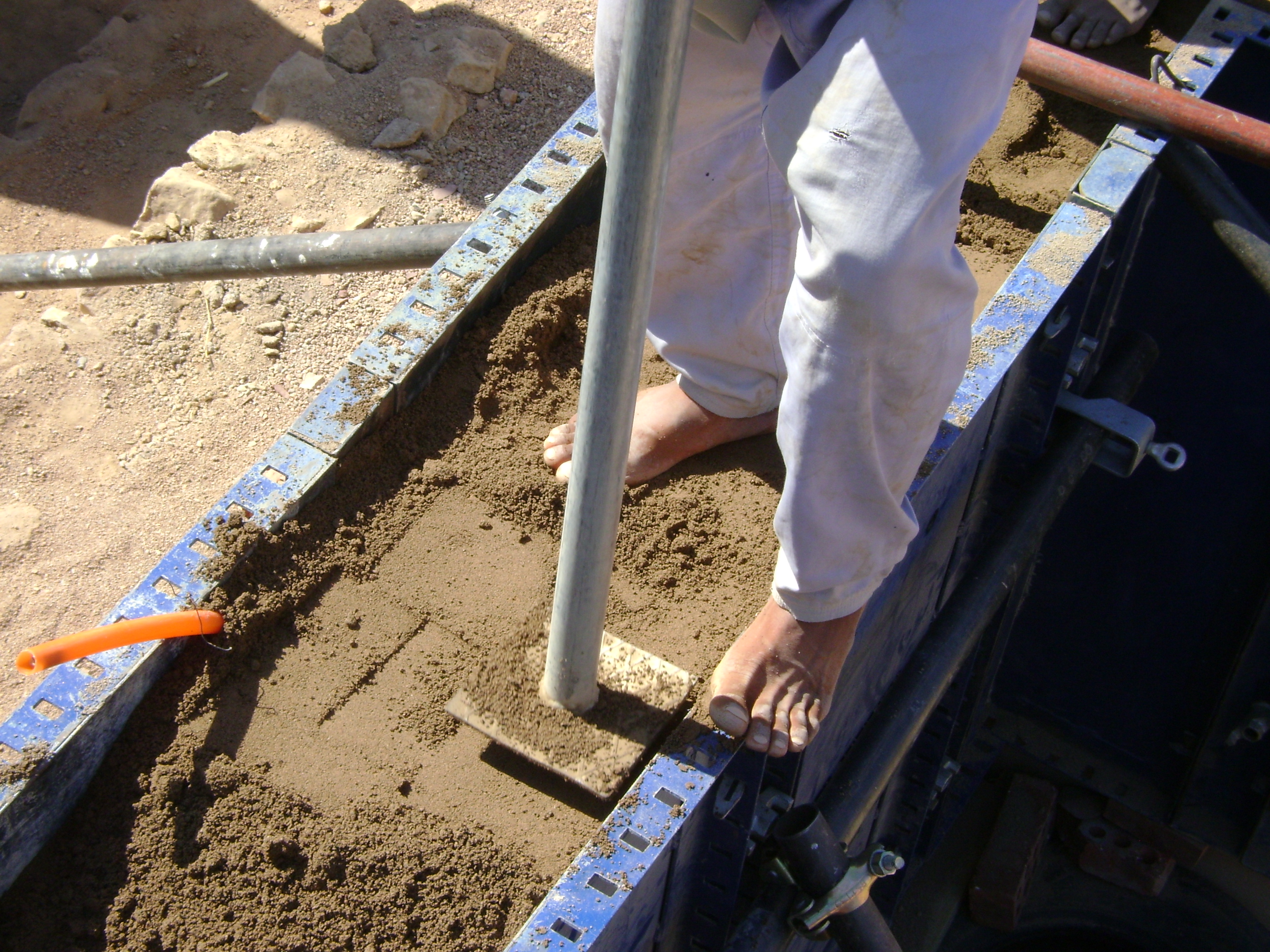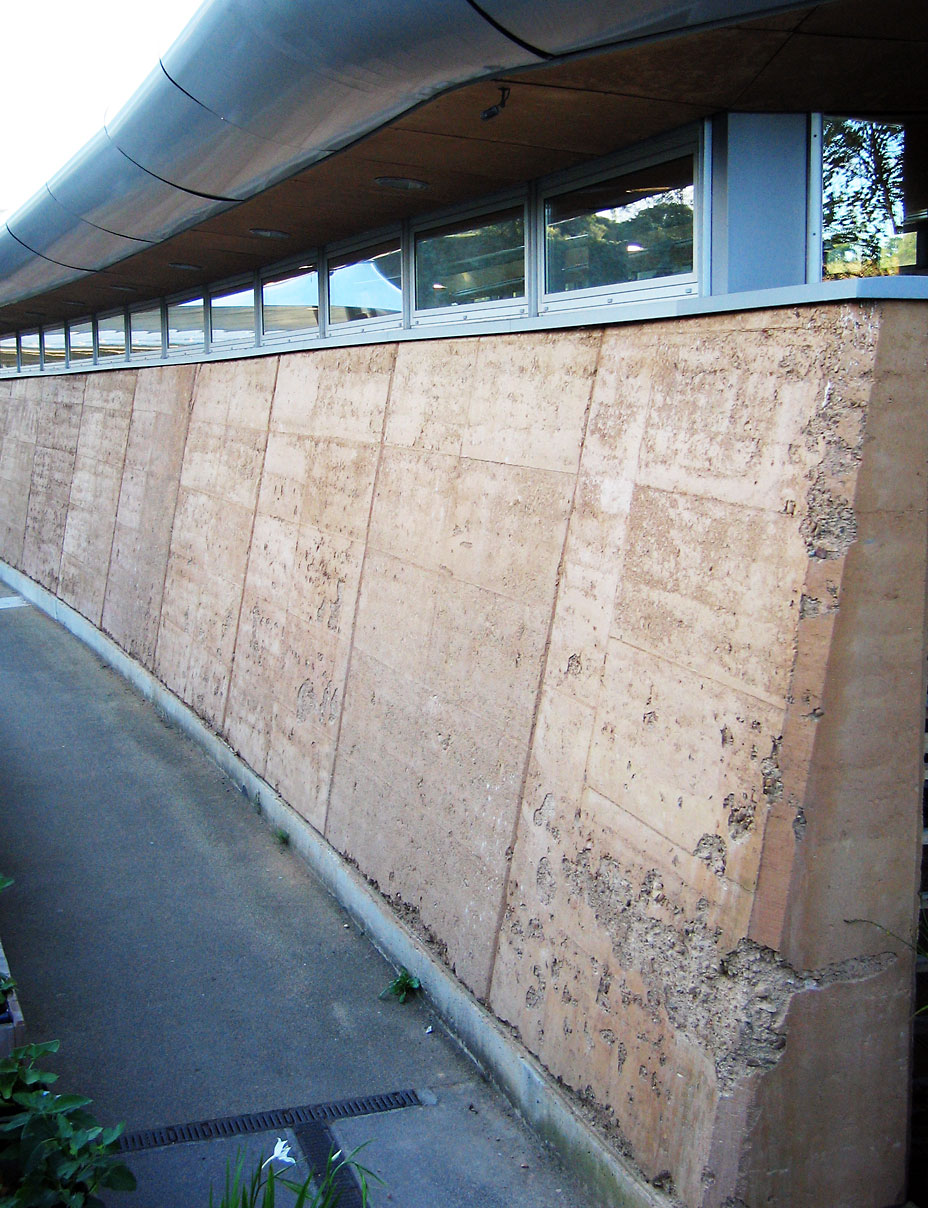Rammed earth
 A typical rammed earth framework consists of two parallel forms filled in with a layer of damp earth, which may include sand, gravel, clay and possibly some type of stabilising agent to produce a freestanding rammed earth block. A typical rammed earth framework consists of two parallel forms filled in with a layer of damp earth, which may include sand, gravel, clay and possibly some type of stabilising agent to produce a freestanding rammed earth block.
|
Contents |
[edit] Introduction
The rammed earth construction method is a process of compacting a mixture of soils or aggregates into formwork (or shuttering). The mixture is then compressed (or tamped) manually or mechanically, to form foundations, floors, walls and so on. When made into walls, these rammed earth components are sometimes referred to as pise.
The layers can be rammed continually until the component is complete, with no need to wait for each layer to dry out. The formwork is then removed and a solid, hard building component is produced.
[edit] History
The rammed earth technique is an ancient method of construction, with evidence of its use dating as far back as the Neolithic Period. Early rammed earth structures were made from a mixture of clay-rich soil, water and natural stabilisers (such as animal urine, animal blood, plant fibres and so on).
Rammed earth was used in many parts of the world including South America, India, the Middle East and Africa. This method was not frequently employed in Europe, although some examples survive in France, and it was more popular in parts of Spain. Significant portions of the Alhambra in Grenada (built chiefly between 1238 and 1358) were constructed using this method.
This building method was common in China, where early evidence of rammed earth structures has survived from the second imperial dynasty (202 BC to 220 AD). Several centuries later, large portions of the Great Wall of China (primarily built during the Ming dynasty 1368 to 1644), were also constructed using this method.
[edit] Modern use
Significant monuments and more common architectural structures built using this method have survived into the 21st century, demonstrating its durability. However, the popularity of rammed earth throughout most parts of the world declined with the introduction of modern materials and methods of construction.
In the late 20th century, its popularity surged again amongst architects with an interest in environmental sensitivity and locally sourced - and readily available - materials. These components can include chalk, lime, gravel, sand, silt or clay. Ideally, the soil should be high in sand and low in clay, with modern formulations reinforced by other structures such as beams.
Cement can also be added to the mixture to improve stabilisation characteristics. This formulation, which has become general practice in Australia, is sometimes referred to as stabilised rammed earth (SRE) or cement-stabilised rammed earth (CSRE). It is acknowledged that the addition of cement can reduce the sustainability of this formulation.
Wall thicknesses are usually at least 30 cm, which creates conditions for high thermal capacity and moderate temperature fluctuations. Insulation can be incorporated to improve thermal performance, and protection measures (such as overhangs) can be added to prevent damage caused by water. Surfaces can also be finished with plaster, bitumen or linseed oil.
[edit] Practical considerations
When successfully produced, rammed earth components can exhibit good compressive strength, durability and aesthetic appeal. However, the success of rammed earth construction in a practical sense may be dependent on climate conditions and the availability of suitable materials.
The method typically works best in locations with high humidity and relatively moderate temperatures. In colder climates, rammed earth walls may need additional insulation, while in locations with high rainfall, they will require protection from rain.
In the UK, there has been some interest in rammed earth construction methods. However, the country’s climate has prevented it from becoming widely adopted.
|
After five years, the corner of the wall at the entrance of the Eden Project already showed surface damage. Although, given the thickness of the walls this probably is not significant and may be partly down to lack of testing and education about this method. |
One high profile example of rammed earth in the UK can be found at the entrance of the Eden Project in Cornwall. Many aspects of the Eden Project championed sustainability, and due to their thermal mass, rammed earth walls fit in with the organisation's environmental ambitions.
[edit] Related articles on Designing Buildings
Featured articles and news
Great British Energy install solar on school and NHS sites
200 schools and 200 NHS sites to get solar systems, as first project of the newly formed government initiative.
600 million for 60,000 more skilled construction workers
Announced by Treasury ahead of the Spring Statement.
The restoration of the novelist’s birthplace in Eastwood.
Life Critical Fire Safety External Wall System LCFS EWS
Breaking down what is meant by this now often used term.
PAC report on the Remediation of Dangerous Cladding
Recommendations on workforce, transparency, support, insurance, funding, fraud and mismanagement.
New towns, expanded settlements and housing delivery
Modular inquiry asks if new towns and expanded settlements are an effective means of delivering housing.
Building Engineering Business Survey Q1 2025
Survey shows growth remains flat as skill shortages and volatile pricing persist.
Construction contract awards remain buoyant
Infrastructure up but residential struggles.
Home builders call for suspension of Building Safety Levy
HBF with over 100 home builders write to the Chancellor.
CIOB Apprentice of the Year 2024/2025
CIOB names James Monk a quantity surveyor from Cambridge as the winner.
Warm Homes Plan and existing energy bill support policies
Breaking down what existing policies are and what they do.
Treasury responds to sector submission on Warm Homes
Trade associations call on Government to make good on manifesto pledge for the upgrading of 5 million homes.
A tour through Robotic Installation Systems for Elevators, Innovation Labs, MetaCore and PORT tech.
A dynamic brand built for impact stitched into BSRIA’s building fabric.
BS 9991:2024 and the recently published CLC advisory note
Fire safety in the design, management and use of residential buildings. Code of practice.






















